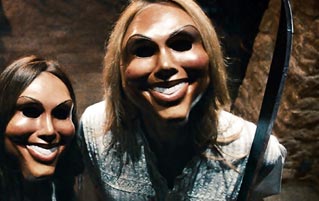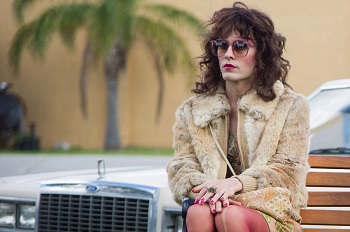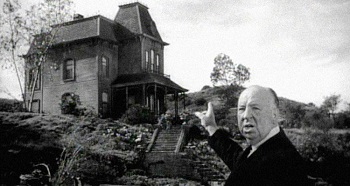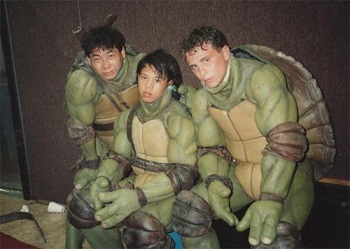6 WTF Ways Major Blockbusters Tried To Save A Buck

Movies today cost insane amounts of money, and why not? When you've got the ability to earn literally a billion dollars at the box office, it makes sense to sink $10 million of your special effects budget into the Hulk's nipples. But plenty of films have to work on a shoestring budget, and sometimes they prove to the fat cats of Hollywood that you don't need no stinking financing to produce something groundbreaking.
The First Terminator Movie Was Shot Illegally
Science fiction isn't exactly a genre that lends itself to low-budget filmmaking. Take The Terminator, a movie that features cyborgs and time travel. How in the hell did that get made without ungodly amounts of money? Illegally, that's how.

For years, James Cameron and his future wife, Gale Anne Hurd, gathered every bit of money (including their own) to make The Terminator happen. Luckily, Cameron's background was in cheap horror movies, where he learned "guerilla filming," also known as hobo movie magic. This allowed him to cut corners while still making the movie look beautiful. The steely cold lighting? Having no budget for electricity, Cameron walked around Los Angeles with a location scout to find streets to film in that had mercury-vapor lights he could film under at night. The ominous fog? The Terminator was filmed during the 1982 Mexican Fruit Fly panic, when Los Angeles was covered in a thick mist of pesticide. At first, Cameron wanted to wait for it to clear, but then wound up using the mist for added effect. He saw no problem in making his actors walk through clouds of actual poison, aside from assuring that The Terminator 40-year-anniversary reunion is going to be one hell of a bummer.

Almost the entire movie was also shot after dusk, adding to its dark and gloomy tone. But why go through all that hassle? Because if they filmed at night, they would have had less of a chance of getting caught by the police and fined for filming without a permit, and they actually had a couple close calls. During the iconic scene where Ah-nold steals a car by punching through its window, it was just Cameron and Schwarzenegger filming by themselves on a suburban street, because on the off chance that they were busted, nobody else would get in trouble. And the actual final shot, where Sarah Connor drives away into the desert, was even riskier. They needed to wait until morning for the day to get hot enough for heat ripples. After not having seen another car on the road for hours, the first one to appear ... was a cop car. However, when the officer pulled over and asked for their filming permits, they lied and said they were doing a student project at UCLA. Remember kids, your student ID isn't just useful for discounts around town, it's also an alibi.
Dallas Buyers Club Won An Oscar For Best Makeup On $250
The movie Dallas Buyers Club, despite having an already bare-bones budget, pulled off a coup by landing Matthew McConaughey and Jared Leto for the lead roles. To celebrate that, producers truly embraced the theme of the movie: by pulling funding and letting a lot of vulnerable people twist in the wind.
Right before filming was set to begin, the money people pulled $8 million from the budget, making its future uncertain. Even worse, production could not be postponed as McConaughey, who, having lost several bowling balls' worth of weight for the role, was already set to go live in a McDonald's to bulk back up for his next project.

Eventually, the team managed to get some additional money so that filming could go forward, but it wasn't anywhere near $8 million, so a lot of corners had to be cut. At one point, production was so broke that a strip club scene's lighting was replaced with candles to save on electricity. That forced frugality is why it's amazing that Dallas Buyers Club won the Oscar for Best Makeup, seeing as all the makeup people had to work with was about $250. Quite a few people reading this probably have more makeup sitting in their bathroom right now.

That $250 had to cover making Matthew McConaughey look like an AIDS patient and Jared Leto like an 80s party girl, and that's just the beginning. They also had to handle makeup for the supporting actors and, by the time they got to the extras, were probably reduced to pinched cheeks and authentic bed hair. As McConaughey and Leto had to look worse throughout the film, the makeup had to get more creative. While prosthetic rashes are usually bought in kits, makeup designer Robin Mathews didn't even have the money for that, so she used some cornmeal and grits from her mom's pantry to rub on McConaughey and Leto's skin. Knowing the movie's budget, that was probably her dinner she sacrificed. At least owning an Oscar means she'll never have to snack off an actor's face ever again. Probably.
Psycho Was Filmed As Part Of A TV Show To Save Money
Today, Alfred Hitchcock is seen as one of the greatest filmmakers/professional silhouettes in the history of movies. But back in the 1960s, there was a little less confidence in him -- so little that Paramount was not on board with Hitchcock adapting the novel Psycho into a film. How horrifying! If only those executives could see what's in theaters today.

But Hitchcock, somehow knowing this movie would land his ass in a billion people's top five lists, was willing to take some risks. He even offered to forgo his salary until the film proved a success if only Paramount would give him the chance to make it the way he wanted, but the studio kept being, to put it kindly, rather chickenshit about the whole affair.
Tired of their roadblocks, Hitchcock wanted to go around the studio to realize his movie. But this was before the time you could just shoot a movie with what's in your pockets, so he still needed a full crew. Luckily, he knew just where to find one: over at Universal where his TV show, Alfred Hitchcock Presents, was being shot. Hitchcock secretly used his own show's crew to film both his show and Psycho all within the same budget, trying to approach the movie like an extended TV episode to save money. Imagine if J.J. Abrams had tried to film Super 8 and disguise it as an Alias episode. That's how bonkers of an idea this was for Hitchcock to pursue.


Despite it being one of the greatest movies ever made, there's still a ton of evidence in the movie of how Hitchcock's constraints were incorporated. For example, the reason the film takes place around Christmas is because Hitchcock noticed that there was accidentally a bunch of Christmas decorations in the background of some of his footage. He was forced to add a title to address the issue, possibly knowing that someday, some snarky internet comedians would point out all of its small inconsistencies for sport.
Ethan Hawke Slept On A Couch While Making The Purge
The Purge was always an ambitious concept: a movie based on the assumption that people can keep their murder boners in their pants for 364 days out of the year. It's even more ambitious when you discover that they made an entire movie set in a dystopian alternative universe with less of a budget than the porn being shot in the house next door.

The Purge came from a studio called Blumhouse Productions, which really made a name for itself by making high-end low-budget horror movies, such as the Paranormal Activity franchise. But even though it had started coming into some money by the time it made The Purge, Blumhouse was still a fledgling company that couldn't really afford to screw anything up. The movie's budget was originally around $8 million, but producer Jason Blum was having trouble figuring out why. He reasoned that since the film pretty much all takes place in a house, there was no reason they couldn't save a few (million) bucks, and slashed the budget down to about $2.5 million. Maybe Hollywood wouldn't have such an elitism problem if more filmmakers treated their projects like a going-out-of-business sale.

How did he manage to trim $5.5 million? By hiring a golden goose and treating it like a shit chicken. Instead of giving movie star Ethan Hawke a trailer and other normal actor accommodations, Blum offered to let Hawke sleep on his couch for the duration of the shoot. And instead of an upfront salary, Hawke agreed to simply a percentage of the profits. Blum thinks it's actually a great business model -- if he can lure "undervalued" actors in for a percent rather than a total sum, effectively letting them bet on themselves. And since The Purge ended up becoming a huge cultural phenomenon and making just, so much money, Hawke eventually won that bet. He might even have enough money for a small couch of his very own.
The Sets Of Dr. No Were Just Used Furniture And Fake Artwork
Probably nine-tenths of the reason anyone watches James Bond is because he's a well-dressed man with a lot of fancy toys that cause a shit ton of collateral damage. So it goes without saying that a lot of money goes into equipping a man that way -- with the exception of Dr. No.
The entire budget of Dr. No was around a million dollars, which today wouldn't even be enough to get Daniel Craig to read a tweet out loud. Not only that, but Dr. No was quite the expensive story. According to the novel, the villain's evil lair is situated in a castle along the coast of Japan, and while a book can create a coastal Japanese castle with just the power of imagination, you may know that in the real world, feudal Japan tended to build castles fairly far from the shore. So in order not to have to build a medieval castle from the ground up, the Dr. No producers decided to set the villainous lair inside a volcano. Great compromise, guys.

Of course, lacking access to any volcanoes, they built one at an outdoor studio lot for, you guessed it, about a million dollars. This left virtually nothing for the rest of the sets. Dr. No's apartment was supposed to have an aquarium in it, but rather than waste money on a functional aquarium, they just projected stock footage of fish into a tank. Production was also forced to fill the sets with random pieces of furniture instead of expensive sets, pretending that Dr. No himself would have an eclectic taste in design and not that he got his furniture from the same place most broke college students do -- the side of the road. But one of the most hilarious things they did was imagine that Dr. No would have some stolen art hanging up, so they painted a copy of a stolen Goya painting ... which was later itself stolen. Its ironic value is estimated to be priceless.

Even though the sets were later considered to be "exemplary," the film still didn't have enough money to even put the set designers' names in the credits. The producers did, however, give art director Ken Adam a gold pen. Whoever said Hollywood is a thankless business?
The 1990 Teenage Mutant Ninja Turtles Was An Independent Film (That No One Wanted To Touch)
Independent movies tend to be some of the most thoughtful and well-crafted movies today. But back in the 90s, they were an absolute goddamned nightmare. Exhibit A: the 1990 Teenage Mutant Ninja Turtles.
At a time when people thought that superhero movies were hot garbage (which might as well be somewhere in the BCs from our current perspective), Teenage Mutant Ninja Turtles wasn't exactly wooing the studios. With no major funding, the producers decided they would go indie, which fortunately did not mean they were going to make a movie about Raphael and Leonardo moving to a small New England town to reconnect with their long estranged mother while also owning and operating a stationery store.

But with indie movies comes indie problems. In particular, the costuming. No actor wanted to wear a turtle costume that weighed more than a suit made out of actual turtle shells. Fortunately, the producers realized that the action scenes with the costumes could be just as easily duplicated by stunt doubles in Hong Kong for way less money -- a process they repeated with TMNT action figures. But even with professional badasses, the shells slowed everything down. The first thing they set out to shoot was a simple scene where the turtles walk into the sewer where they live. Easy, right? Well, the latex turtle suits didn't exactly agree with the slippery floor of a wet sewer and the actors kept wiping out in non-bodacious fashion. A simple walking sequence took like eight hours to shoot.

But that didn't solve all of their money problems. The turtles still looked like crap without some amazing animatronics, so they couldn't just hand that over to the lowest bidder. Instead, they tried to convince the highest bidder not to bid too high. The producers decided to try and convince legendary puppeteer and imagination machine Jim Henson to handle the turtles, but for lower than his normal fee. Henson, his heart as soft as felt, would only do it after the producers showed him a whole bunch of source material just to prove that it wasn't going to be too violent. And while the finished film was still considerably more violent than the cartoon (not a single child in the 1980s was a Turtles fan because of the comics), the lack of any onscreen decapitations was a small price to pay for the genius of Jim Henson.
Sadly, Jim Henson was too dead to consult on the most recent TMNT movies. We assume he would have objected to the dick jokes.
Isaac needs money, or at least some more Twitter followers.
Also check out 6 Famous Movie Moments That Look Hilarious With CGI Removed and 7 Movie Special Effects You Won't Believe Aren't Computers.
Subscribe to our YouTube channel, and check out 20 Movie Special Effects You Won't Believe Aren't CGI, and other videos you won't see on the site!
Follow us on Facebook, and we'll follow you everywhere.